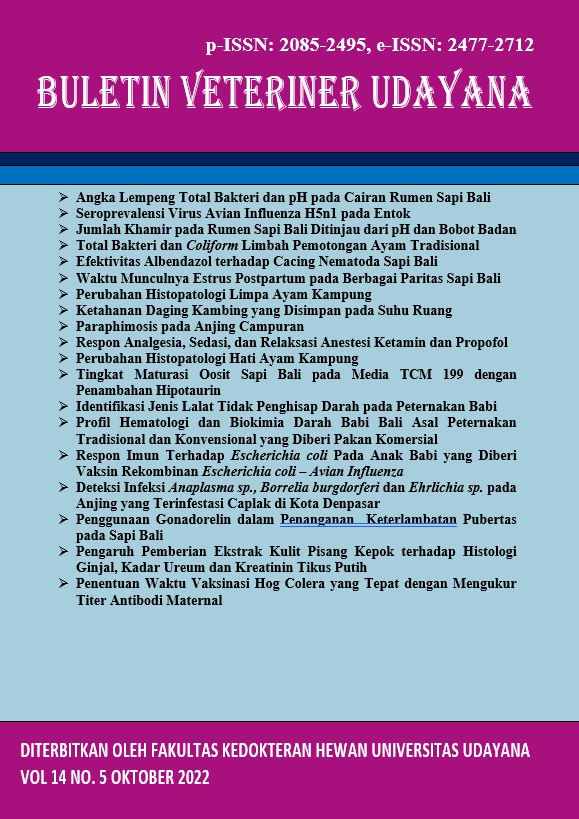TIMING OF HOG COLERA VACCINATION BY MEASURING MATERNAL ANTIBODY TITERS
Abstract
Pigs are livestock that have relatively rapid growth and development, as a source of animal protein has a high economic value. However, raising pigs is often infected with the Hog cholera virus. Hog Cholera is characterized by sudden death with high morbidity and mortality. Disease control through vaccination has been carried out, but cases of disease still occur. The success of vaccination can be influenced by various factors, including: the vaccine factor, the implementer, and the animal factor. This study aims to determine the maternal antibody titer of piglets from sows who have been vaccinated against hog cholera. The study used 10 samples of piglets from sows that had been vaccinated. Serum samples were taken on days 7, 14, and 21. Antibody titers were checked using ELISA. The data obtained were analyzed using analysis of variance. The results showed that there was a significant decrease in maternal antibody titers (p<0.05) on the 14th and 21st days compared to the 7th day. There is a significant relationship (p<0.05) between age (days) and the value of optical density (OD) of maternal antibodies, the correlation coefficient is 0.852, with the equation Y=1.195e-0.021X. The conclusion is that the older the piglets are, the lower the OD value will be, but the longer the decline is, the smaller the decrease. At the age of 42 days, the maternal antibody OD value will reach 0.50, so it is feasible to be vaccinated.
Downloads
References
Agustina KK, Wirata IW, Dharmayudha AAGO, Kardena IM, Dharmawan NS. 2016. Increasing farmer income by improved pig management systems. Bul. Vet. Udayana. 8(2): 122-127.
Artois MP, Depner V, Guberti J, Hars S, Rossi, Rutelli D. 2002. Classical Swine Fever (Hog cholera) in wild boar in Europe. Rev. Sci. Tech. Off. Int. Epi. 21(2): 287-303.
Butler JE, Lager KM, Splichal I, Francis D, Kacskovics I, Sinkora M, Wertz N, Sun J, Zhao Y, Brown WR, DeWald R, Dierks S, Muyldermans S, Lunney JK, McCray PB, Rogers CS, Welsh MJ, Navarro P, Klobasa F, Habe F, Ramsoondar J. 2008. The piglet as a model for B cell and immune system development. Vet. Immunol. Immunopathol. 128: 147–170.
Deptan. 2012. Pedoman Pelaksanaan Penataan Usaha Budidaya Babi Ramah Lingkungan Tahun 2012.
Gomez VJE, Ruiz VE, Bautista MJ, Sanchez CP. 2001. Morphologiacal and immunohistochemical changes in splenic macrophages of pig infected with classical swine fever. J. Comp. Pathol. 125(2-3): 98-109.
Greiser WI, Blome S, Moennig V. 2007. Diagnostic methods for detection of Classical swine fever virus status quo and new developments. J. Vaccine. (25): 5524-5530.
Hasselquist D, Nilsson J-Å. 2009. Maternal transfer of antibodies in vertebrates: trans- generational effects on offspring immunity. Philos. Trans. Royal Soc. B: Biol. Sci. 364(1513): 51-60.
Johnson RP, Povey RC. 1983. Transfer and Decline of Maternal Antibody to Feline Calicivirus. Can. Vet. J. 24(1): 6–9.
Keputusan Menteri Pertanian (Kepmentan). 2013. Penetapan Jenis Penyakit Hewan Menular Strategis. NOMOR 4026/Kpts./OT.140/3/2013.
Lipowski M, Drexler C, Pejsak Z. 2000. Safety and efficacy of a classical swine fever subunit vaccine in pregnant sows and their offspring. Vet. Microb. 15: 99-108.
Liu J, Fan XZ, Wang Q, Xu L, Zhao QZ, Huang W, Zhou YC, Tang B, Chen L, Zou XQ, Sha S, Zhu YY. 2011. Dynamic distribution and tissue tropism of classical swine fever virus in experimentally infected pigs. Virol. J. 2(8): 201.
Niewiesk S. 2014. Maternal antibodies: clinical significance, mechanism of interference with immune responses, and possible vaccination strategies. Front. Immunol. 5: 446.
Ratundima EM, Suartha IN, Mahardhika IGNK. 2012. Deteksi antibodi terhadap virus Classical Swine Fever dengan teknik Enzyme-Linked Immunosorbent Assay. Indon. Med. Vet. 1(2): 217-227.
Rolf MZ. 2001. Maternal antibodies, childhood infections, and autoimmune diseases. NEJM. 345(18): 1331-1335.
Sarosa A, Sendow I, Syafriati T. 2004. Pengamatan Status Kekebalan Terhadap Penyakit Hog Cholera Dengan Teknik Neutralization Peroxidase Linked Essay. Balai Penelitian Veteriner.
Santhia K, Dewi AA, Punartha N, Sutami N, Faesal LM. 2011. Laporan Hasil Survaillans dan Monitoring di Wilayah Kerja Balai Besar Veteriner Denpasar.
Sihombing DTH. 2006. Ilmu Ternak Babi. Institut Pertanian Bogor. Gajah Mada University Press. Yogyakarta.
Subronto. 2003. Ilmu Penyakit Ternak (Mamalia). Gajah Mada University Press. Yogyakarta.
Vandeputte J, Too HL, Ng FK, Chen C, Chai KK, Liao GA. 2001. Adsorption of colostral antibodies against classical swine fever, persistence of maternal antibodies, and effect on response to vaccination in baby pigs. Am. J. Vet. Res. 62(11): 1805-1811.
Wirata IW, Dewi IAC, Putra IGNN, Winaya IBO, Suardana IBK, Sari TK, Suartha IN, Mahardika IGNK. 2010. Deteksi virus Classical Swine Fever di Bali dengan RT-PCR. J. Vet. 11(3): 144-151.





